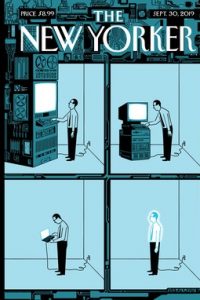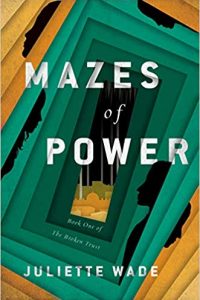Stefan Dziemianowicz reviews Brian Evenson
 The most unusual story in Windeye, Brian Evenson’s outstanding new collection of short fiction, is devoid of the reality slips and nods to the supernormal that distinguish the other 24 stories in the book. In fact, it doesn’t even read like fiction. In ‘‘Bon Scott: The Choir Years’’, Evenson, addressing the reader as himself, relates how in 1997, while living in Utah and researching an article that he was writing on the Australian hard rock band AC/DC, he uncovered evidence that Bon Scott, the band’s lead singer, had made several trips to Salt Lake City to practice with the Mormon Tabernacle Choir. His last trip occurred only months before Scott died in 1979, after a night of excessive drinking. The incongruity of someone with Scott’s reputation for wildness cozying up to the Mormons – and the discovery that Scott was baptized into the Mormon faith, posthumously, on the day of his death – leads Evenson to speculate whether Scott’s death wasn’t engineered, by himself or others, as a ‘‘Blood Atonement’’ for sins so great ‘‘that the blood of Christ cannot sufficiently cleanse.’’
The most unusual story in Windeye, Brian Evenson’s outstanding new collection of short fiction, is devoid of the reality slips and nods to the supernormal that distinguish the other 24 stories in the book. In fact, it doesn’t even read like fiction. In ‘‘Bon Scott: The Choir Years’’, Evenson, addressing the reader as himself, relates how in 1997, while living in Utah and researching an article that he was writing on the Australian hard rock band AC/DC, he uncovered evidence that Bon Scott, the band’s lead singer, had made several trips to Salt Lake City to practice with the Mormon Tabernacle Choir. His last trip occurred only months before Scott died in 1979, after a night of excessive drinking. The incongruity of someone with Scott’s reputation for wildness cozying up to the Mormons – and the discovery that Scott was baptized into the Mormon faith, posthumously, on the day of his death – leads Evenson to speculate whether Scott’s death wasn’t engineered, by himself or others, as a ‘‘Blood Atonement’’ for sins so great ‘‘that the blood of Christ cannot sufficiently cleanse.’’
This story may be complete bunk, but if so it is magnificently well-written bunk. Evenson supports his startling ‘‘revelation’’ with records, interviews, and even lyrics purportedly written by Scott that Christianize lyrics of AC/DC songs. He also makes the most of the Mormon faith’s insularity, presenting the evidence he uncovers as exactly the sort of data a button-down church would want to keep sub rosa (and that those of us not of the faith would love to learn that the Church is keeping secret). Interestingly, this very factually related narrative has several features that resonate perfectly with concerns touched on in the stories that are more obviously fiction – not the least of them being a glimpse of a secondary world whose discovery casts doubts on the certainties of our own, and a story that ends with more questions than answers.
Secondary realities, and the metaphysical problems they pose to those who stumble upon them, are what Evenson’s tales are all about. In ‘‘Baby or Doll’’, the protagonist revisits an emotionally troubling experience that he has been wrestling with throughout the story, and sees ‘‘the briefest glimpse, as if a hole had opened up to reveal yet an additional world – something.’’ This describes the discomposing experiences characters have in most of the other stories, where the sense of that additional world’s existence causes them to doubt their sanity and the security of the reality they have believed in up to that point. The catalyst is usually an emotionally jarring experience, often the loss of someone intimate – a sibling, a child, a parent. In the title tale, a young brother and sister discover from an inspection of their house that it has one more window on its exterior than they can account for from inside. When the sister reaches out to touch that window, she disappears – and when the boy tell his mother what happened, she shocks him with the revelation that he never had a sister. Has the boy just imagined his sister? Has he been jolted into a secondary world where he never had a sister? Is there a reality in which he himself does not exist? Evenson leaves these questions tantalizingly unanswered, well aware of how disturbing the uncertainties they raise are. In ‘‘The Drownable Species’’, he inverts this process with the same results. A young man, both of whose parents have died mysterious deaths by drowning, is contacted by an older brother whom he never knew he had. Efforts to meet with this brother lead to a series of missteps that result in the brother’s drowning death, and accusations from the investigating authorities not only that the young man does not have a brother, but that the family whose tragedies he is remembering may not be his.
Sometimes, in these stories, the agent that initiates the reality shift is the loss or addition of a body part that fundamentally alters a character’s sense of personal identity. In ‘‘The Other Ear’’, a soldier awakens in a field hospital to find that an ear sheared in battle has been reattached to his head. The problem is, he remembers having lost his ear long before the battle others found the detached ear at. Naturally, the soldier begins hearing a voice that is not his own talking to him through that ear. The narrator of ‘‘The Absent Eye’’ recalls how, despite losing an eye in childhood, he could still see through it – and what he sees is a race of shadowy beings, invisible to people with ordinary sight, who attach themselves to those people. Sometimes, the reality jolt occurs through less dramatic means. In the book’s most poignant tale, ‘‘Discrepancy’’, a woman discovers an gradually lengthening time delay between when people speak to her, and when she hears their voice. Increasingly detached and alienated from her world as the time delay grows longer, she is left with the terrifying thought that ‘‘Everything would eventually arrive, but it would be a long time, if ever, before anything would arrive again when it was actually needed.’’
Characters in these stories frequently describe the off-kilterness of their reality shifts in terms of a kind of lucid dreaming. In ‘‘Baby Doll’’, this is described as ‘‘that curious gray zone of being both asleep and awake, when consciousness had begun to loosen its grip on his body in such a way that he remained unsure of where reality stopped and dream began.’’ Thus, even though the external trappings of these stories vary from horror, to fantasy, science fiction, and crime fiction, their events and characters all seem gauzy and indeterminate, as though they might disappear in the blink of an eye. One senses that Evenson drafted these stories as fuller narratives, then stripped away their surest details until only the most fragile threads were tying their events together, and anchoring them to anything fixed. The result is fiction that, for all its seeming insubstantiality, is weighty, solid, and provocative.








Pingback:26 September 2012 | MormonVoices